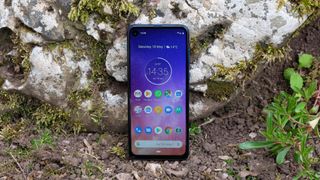Why you can trust TechRadar
Verdict
The Motorola One Action is another fine budget smartphone from Motorola. It continues the good work started with the Motorola One Vision, but with a couple of interesting twists.
Ditching the Vision’s decent camera for a dedicated ultra-wide video lens gives anyone more interested in shooting stable footage a genuine choice. Being able to shoot that video in portrait mode makes the process more comfortable and intuitive, too.
Add the fact that the Motorola One Action is slightly cheaper than its close brother, yet packs the same potent processor, bright display and appealing design (with one or two minor cut backs), and you have a very tempting new option in the busy $250/£200ish category.

Who's this for?
Anyone dealing with a budget of around $250/£200 should seriously consider the Motorola One Action in their deliberations. It’s a strong all-round performer.
If you’re looking for an affordable phone that excels at video, meanwhile, you can bump the One Action up to the top of the list. It shoots stable, sharp and very wide footage, and being able to do so in portrait makes the process that little bit more comfortable.
Should you buy it?
Like its twin brother, the Motorola One Action dares to try something different in the budget smartphone category.
While its video focus and super-stretched display might come across as daringly quirky, however, this is a solid enough all-rounder to be worthy of consideration. Solid design, performance, screen quality and software ensure a decent experience for all, despite a few usability foibles.
First reviewed: September 2019
Not sold? Consider these alternatives:
Motorola One Vision

The Motorola One Action’s most direct competitor arguably comes from within the same family. The One Vision has the same design, chipset and display, and it boasts the same classy Android One OS.
Where the One Vision differentiates itself is with a stronger main camera, which is capable of taking better shots in a greater variety of conditions. It also has a few extra bonuses like a faster charger and better dust resistance.
However, it’s worth pointing out that’s you’ll need to pay £50 (around $60/AU$90) extra for these advantages, and that video enthusiasts won’t be as well served.
Read our full Motorola One Vision review
Sony Xperia 10

The Sony Xperia 10 is another phone that goes with the unusual 21:9 aspect ratio for its display, and at a similar budget price tag to boot.
For our money the Sony doesn’t incorporate this super-long display quite as elegantly as the One Action, with a chunky bezel only accentuating its height. Of course, that also means that you don’t have to put up with a punch-hole selfie cam.
We’re happier with the One Action’s battery life, storage provision, and performance, while its Android One OS comfortably beats Sony’s custom UI.
Read our full Sony Xperia 10 review
Honor 20 Lite

If you’re looking for another triple-lens smartphone for around the $250/£200 mark, the Honor 20 Lite should be included in your deliberations.
It’s more of a stills specialist than the Motorola, and it uses each of those three cameras to create a more flexible snapper overall. It can’t claim the same video prowess, though.
All in all, the uncertainty surrounding the Huawei-owned company and the ugly custom UI should be enough to give the Motorola the nod in most situations.
Read our full Honor 20 Lite review

